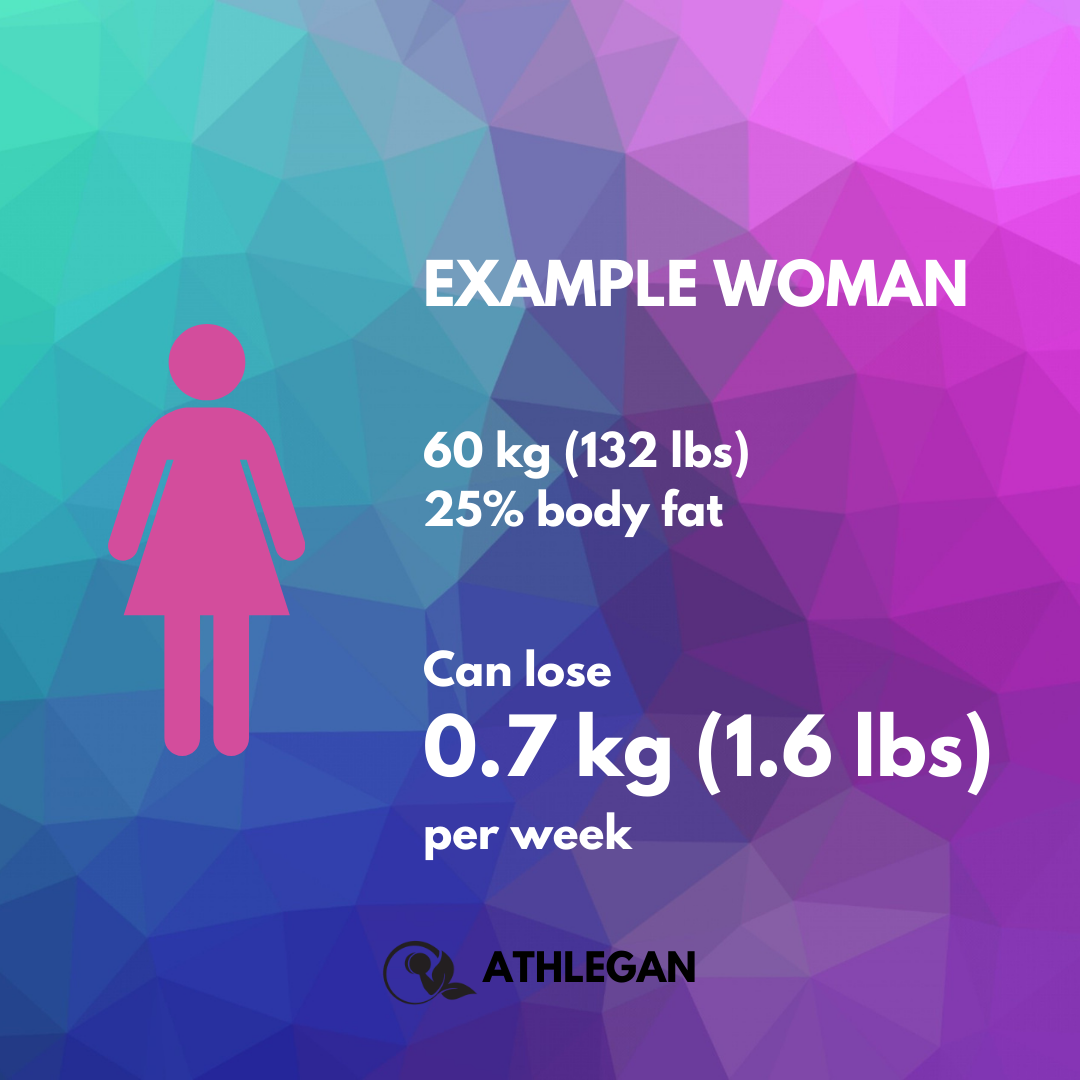The optimal rate of fat-loss for YOU
People normally think about losing weight for a long time before actually taking the plunge. After deciding, however, they usually go all-in, gun blazing, devil may care.
That’s totally understandable. One drop too many finally spilled the glass and you’re done being overfat. Let’s fix this now!
I started out the same, throwing myself head-first into a crash diet and lost my first twenty kilos in just three months. That’s an insane pace and I really, really wish I had known better. It’s taken me years to recover from that.
Don’t repeat my mistake.
Definitely go for a fat-cut if you want to shed some fluff but let’s paint a more nuanced picture first. Let me tell you what I wish someone had told me before I began my first cut.
When I plan fat-cut phases nowadays, for myself or for my clients, I always start by calculating a trajectory. This gives me a plan where I can see, week by week, how much I should be weighing.
Not knowing this, how will you be able to tell if things are progressing according to plan?
How could you expect to push yourself harder when you’re going too slow?
How will you realize it’s time to restrain yourself when going too fast?
Secondary goals
I can hear your inner voice already.
“What do you mean, ’too fast’?! Why not just go as fast as possible?!”
Glad you asked! ;)
If your only concern is to maximize the amount of fat you lose, then go right ahead. Cut hard and fast! Eat nothing but salad and train for hours every day.
Unfortunately, that completely disregards the huge psychological aspect of weight-loss.
It also misses the important fact that most people don’t want to lose fat because they dislike fat in itself but because of the way it makes them look or how it impairs a more optimal performance. This implies there is a set of secondary goals.
You want to cut some fat but you probably don’t want to lose muscle. You would like to lose weight but without being miserable for months. You could drop a size but would also like to maintain your training regimen.
What’s important to you dictates your unique secondary goals but everyone has some.
These secondary goals impose restrictions on your primary goal – e.g. you can’t only care about fat-loss. They pull you in an opposite direction and you have to decide where on this spectrum between primary and secondary goals will be a good balance for you.
As with everything in life, there are pros and cons and this becomes especially apparent at the extremes. So before finding a good balance for you, let’s first have a look at the downsides of minimum and maximum fat-loss rate.
Risks of losing weight too slow
You wouldn’t think there are a lot of cons of losing fat too slow but you’d be wrong.
These are the biggest ones:
- You’ll see less progress week by week, which can be severely demotivating. Long-term adherence is the name of the game and losing motivation can ruin everything.
- It’ll take a lot longer to achieve the same results as a faster cut, which means less time in the year to enjoy life.
- There’s an opportunity cost – every week spent losing fat means a week less growing muscle and becoming stronger.
Cutting fat sucks, no matter how fast you do it. Less so at a slower pace but there’s no getting around the fact that you’re creating an artificial famine for your body and that will never be pleasant.
The constant awareness that you can’t eat this or that, can’t fully enjoy many social events, and having a constant set of restrictions hanging over you, that wears you down.
Risks of losing weight too fast
So, again, why not just go as fast as humanly possible and get it over with? Simply because that comes with its own set of downsides:
- You’ll lose more muscle mass along with the fat mass. If your goal is an aesthetic one, maintaining as much muscle as possible is essential for a good result.
- You’ll suffer exponentially more. Double the fat-cut velocity means enduring more than twice the hardship.
- It’ll be incredibly hard to adhere to the diet for the duration of the cut and long-term adherence is the single most important variable in a successful weight-loss.
After some failed attempts, many people start believing they’re incapable of losing fat when they are actually perfectly able to get in amazing shape if they would just do it properly. (I don’t blame them, though, with all the marketing bullshit being pushed.)
Doing it “properly” is key here. Not too slow and not too fast – Goldilocks fat-loss!
But how do we determine what such a pace is?
One good point of reference we can start with is physiology and the oxidation of of adipose tissue (burning body fat). Science can help us here.
Fat oxidation rate
In science, it’s extremely important to get the semantics right and use the correct terminology.
That’s (one of the reasons) why you can’t have an adult discussion with someone who believes in something like healing crystal vibration energies – they’re incapable of defining what the hell they’re talking about.
For this article, it’s important to make a distinction between weight-loss and fat-loss. It should be clear after reading our article on body fat that your weight is completely irrelevant and what matters is your body fat.
This informs us that of the obvious fact that it’s fat we want to lose. And, luckily, we have pretty good data on just how much fat we’re able to burn (oxidize).
One often-cited calculation[^1] puts this at around 68 kcal per kilo body fat (31 kcal/lbs). The author has later improved his estimates and arrived at a more modest 48 kcal/kg (or 22 kcal/lbs).
E.g. if you carry one kilo of body fat, the most you’ll be able to burn only from fat is 48 kcal worth of energy per day. One kilo of fat contains about 7000 kcal (1 lb = ~3500 kcal).
Converted to real-life examples, that means:
A woman of 60 kg (132 lbs) and 25% body fat can burn 720 kcal worth of fat per day. That’s 0.7 kg (1.6 lbs) per week or 1.2% of her total body weight.
A man of 80 kg (176 lbs) and 15% body fat can burn 576 kcal worth of fat per day. That’s 0.6 kg (1.3 lbs) per week or 0.7% of his total body weight.


This tells us two important things.
- The more fat you have, the more you’re able to burn.
- The more weight you lose, the less of it is from fat.
Let those sink in for a moment. That really summarizes this article.
As a side note, it’s interesting to note that women generally have a higher body fat percentage, which means they can afford a bigger caloric deficit. At the same time, since they’re generally smaller, their starting calories are lower, to begin with, so that bigger drop in calories is going to be tougher.
E.g. it can take longer for women to lose the same amount of fat as men but, on the other hand, they should also be able to retain more of their muscle mass while cutting.
Remember that these numbers are for optimal conditions. If you lose exactly this much weight, chances are high it’ll still not be 100% fat.
Now that we know the dangers of going too fast or too slow and the theoretical limit of fat-loss, let’s get down to business and look at your fat-loss.
Optimal rate of weight-loss
Working through the numbers of different scenarios, this is the recommendation we give:
Aim for between -0.5% and -1.0% of your body weight per week for optimal fat-loss.
- For the example woman, that’s 0.3-0.6 kg (0.7-1.3 lbs) per week.
- For the example man, that’s 0.4-0.8 kg (0.9-1.8 lbs) per week.
You can go faster and slower than this but keep the above risks in mind. The faster you go, the more muscle mass you’ll lose and the harder it’ll be. The slower you go, the longer it’ll take and the more demotivating it will feel.
Also, consider how much body fat you’re carrying around. If you’re obese you could really go after it whereas if you’re already very lean you will probably want to go much slower.
Check our calories guide for a primer on how to make sure you follow a weight-loss plan. Or chat with us about online coaching to see if that could be something to help you get started!
Finally, there are two things you can do to help maintain more muscle mass (and keep weight-loss more focused on fat-loss) during a fat-cut[^2]:
Lift heavy weights. Start following a training program or get into strength sport. Use them or lose them applies very much to your muscles and they have to work hard for your body to hold on to them.
Increase your protein intake. In a deficiency, more protein will be used for fuel and so by throwing in a protein shake you help your body avoid taking protein from your muscles.






